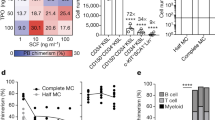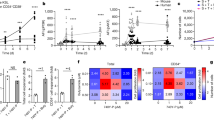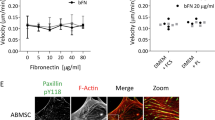Abstract
Peripheral blood progenitor cells are a prime target for gene therapy approaches. As recent data point to the relevance of soluble stroma factors for the efficient transduction of progenitor cells, we tested the stroma-conditioned medium (SCM) of the two cell lines FBMD-1 and L88/5 as well as desulfated and O-sulfated heparin (HS dS and HS OS) for their effect on transduction of peripheral blood progenitor cells. We transduced CD34 + cells of nine tumor patients with the retroviral SF-MDR vector containing the human multidrug resistance 1 ( MDR 1) gene under serum-free conditions on the fibronectin fragment CH-296 with or without SCM. Provirus-specific polymerase chain reaction showed a median 1.6-fold higher integration rate of the transgene into committed progenitor cells for the group with added FBMD-1 SCM ( P =.008). This was maintained after 2 ( P =.02) and, as a trend, after 5 weeks of stroma-dependent long-term culture. We found a median 1.5-fold increase in rhodamine-123 (Rh-123) exclusion in myeloid lineage-committed progeny cells following transduction in the presence of FBMD-1 SCM ( P =.0004). After 2 or 5 weeks of long-term culture, a significantly higher proportion of Rh-123 dull cells could still be detected in the FBMD-1 SCM transduction group ( P =.003 and P =.04, respectively). L88/5 SCM or HS OS or HS dS was not effective as supplement for improving gene transfer. The FBMD-1 stroma cell line appears to secrete a unique moiety, which can increase retroviral transduction of lineage-committed and primitive progenitor cells. The FBMD-1 stroma activity is not attributable to heparan sulfate. Cancer Gene Therapy (2001) 8, 440–449
This is a preview of subscription content, access via your institution
Access options
Subscribe to this journal
Receive 12 print issues and online access
$259.00 per year
only $21.58 per issue
Buy this article
- Purchase on Springer Link
- Instant access to full article PDF
Prices may be subject to local taxes which are calculated during checkout
Similar content being viewed by others
References
Galski H, Sullivan M, Willingham MC, et al . Expression of a human multidrug resistance cDNA ( MDR 1) in the bone marrow of transgenic mice: resistance to daunomycin-induced leukopenia Mol Cell Biol 1989 9: 4357–4363
Sorrentino BP, Brandt SJ, Bodine D, et al . Selection of drug-resistant bone marrow cells in vivo after retroviral transfer of human MDR 1 Science 1992 257: 99–103
Boesen JJ, Brouwer K, Hospers G, et al . Introduction of the human MDR 1 gene into hematopoietic stem cells to improve cancer chemotherapy In: Zeller WJ, Eisenbrand G, Hellmann K, eds. Reduction of Anticancer Drug Toxicity. Pharmacologic, Biologic, Immunologic and Gene Therapeutic Approaches. Series title: Contributions to Oncology Basel: Karger 1995 48: 118–124
Hanania EG, Fu S, Zu Z, et al . Chemotherapy resistance to taxol in clonogenic progenitor cells following transduction of CD34-selected marrow and peripheral blood cells with a retrovirus that contains the MDR-1 chemotherapy resistance gene Gene Ther 1995 2: 285–294
Licht T, Aran JM, Goldenberg SK, et al . Retroviral transfer of human MDR 1 gene to hematopoietic cells: effects of drug selection and of transcript splicing on expression of encoded P-glycoprotein Hum Gene Ther 1999 10: 2173–2185
Schiedlmeier B, Wermann K, Kühlcke K, et al . Human multidrug resistance-1 gene transfer to long-term repopulating human mobilized peripheral blood progenitor cells Bone Marrow Transplant 2000 25: (Suppl 2) 118–124
Hesdorffer C, Ayello J, Ward M, et al . Phase I trial of retroviral-mediated transfer of the human MDR 1 gene as marrow chemoprotection in patients undergoing high-dose chemotherapy and autologous stem cell transplantation J Clin Oncol 1998 16: 165–172
Moscow JA, Huang H, Carter C, et al . Engraftment of MDR 1 and NeoR gene-transduced hematopoietic cells after breast cancer chemotherapy Blood 1999 94: 52–61
Miller DG, Adam MA, Miller AD . Gene transfer by retrovirus vectors occurs only in cells that are actively replicating at the time of infection [published erratum appears in Mol Cell Biol. 1992;12:433] Mol Cell Biol 1990 10: 4239–4242
Dao MA, Nolta JA . Molecular control of cell cycle progression in primary human hematopoietic stem cells: methods to increase levels of retroviral-mediated transduction Leukemia 1999 13: 1473–1480
Bhatia M, Bonnet D, Kapp U, et al . Quantitative analysis reveals expansion of human hematopoietic repopulating cells after short-term ex vivo culture J Exp Med 1997 186: 619–624
Luens KM, Travis MA, Chen BP, et al . Thrombopoietin, kit ligand, and flk2/flt3 ligand together induce increased numbers of primitive hematopoietic progenitors from human CD34 + Thy-1 +Lin - cells with preserved ability to engraft SCID-hu bone Blood 1998 91: 1206–1215
Murray L, Luens K, Tushinski R, et al . Optimization of retroviral gene transduction of mobilized primitive hematopoietic progenitors by using thrombopoietin, Flt3, and Kit ligands, and RetroNectin culture Hum Gene Ther 1999 10: 1743–1752
Schiedlmeier B, Buss EC, Veldwijk MR, et al . Soluble bone marrow stroma factors improve the efficiency of retroviral transfer of the human multidrug resistance 1 gene to human mobilized peripheral blood progenitor cells Hum Gene Ther 1999 10: 1443–1452
Verfaillie CM . Adhesion receptors as regulators of the hematopoietic process Blood 1998 8: 2609–2612
Hurley RW, McCarthy JB, Verfaillie CM . Direct adhesion to bone marrow stroma via fibronectin receptors inhibits hematopoietic progenitor proliferation J Clin Invest 1995 96: 511–519
Coulombel L, Auffray I, Gaugler MH, Rosemblatt M . Expression and function of integrins on hematopoietic progenitor cells Acta Haematol 1997 97: 13–21
Breems DA, Blokland EAW, Ploemacher RE . Stroma-conditioned media improve expansion of human primitive hematopoietic stem cells and progenitor cells Leukemia 1997 11: 142–150
Herman P, Ferrant A, De Bruyere M, Straetmans N . Stromal factors support the expansion of the whole hemopoietic spectrum from bone marrow CD34 +DR - cells and of some hemopoietic subsets from CD34 + and CD34 +DR + cells Leukemia 1998 12: 735–745
Gupta P, Oegema TR Jr, Brazil JJ, et al . Structurally specific heparan sulfates support primitive human hematopoiesis by formation of a multimolecular stem cell niche Blood 1998 92: 4641–4651
Shih CC, Hu MCT, Hu J, et al . A secreted and LIF-mediated stromal cell–derived activity that promotes ex vivo expansion of human hematopoietic stem cells Blood 2000 95: 1957–1966
Gupta P, Oegema TR Jr, Brazil JJ, et al . Human LTC-IC can be maintained for at least 5 weeks in vitro when interleukin-3 and a single chemokine are combined with O-sulfated heparan sulfates: requirement for optimal binding interactions of heparan sulfate with early acting cytokines and matrix proteins Blood 2000 95: 147–155
Sutherland HJ, Lansdorp PM, Henkelman DH, et al . Functional characterization of individual human hematopoietic stem cells cultured at limiting dilution on supportive marrow stromal layers Proc Natl Acad Sci USA 1990 87: 3584–3588
van Hennik PB, de Koning AE, Ploemacher RE . Seeding efficiency of primitive human hematopoietic cells in nonobese diabetic/severe combined immune deficiency mice: implications for stem cell frequency assessment Blood 1999 94: 3055–3061
Thalmeier K, Meissner P, Reisbach G, et al . Establishment of two permanent human bone marrow stromal cell lines with long-term post irradiation feeder capacity Blood 1994 83: 1799–1807
Breems DA, Blokland EAW, Neben S, Ploemacher RE . Frequency analysis of human primitive haematopoietic stem cell subsets using a cobblestone area forming cell assay Leukemia 1994 8: 1095–1104
Baum C, Hegewisch-Becker S, Eckert HG, et al . Novel retroviral vectors for efficient expression of the multidrug resistance ( mdr -1) gene in early hematopoietic cells J Virol 1995 69: 7541–7547
Eckert HG, Stockschläder M, Just U, et al . High-dose multidrug resistance in primary human hematopoietic progenitor cells transduced with optimized retroviral vectors Blood 1996 88: 3407–3415
Fruehauf S, Breems DA, Knaän-Shanzer S, et al . Frequency analysis of multidrug resistance-1 gene transfer into human primitive hematopoietic progenitor cells using the cobblestone area-forming cell assay and detection of vector-mediated P-glycoprotein expression by rhodamine-123 Hum Gene Ther 1996 7: 1219–1231
Fleiss JL . The parallel groups design In: The Design and Analysis of Clinical Experiments New York: John Wiley and Sons; 1986 60–63
Haas R, Möhle R, Fruehauf S, et al . Patient characteristics associated with successful mobilizing and autografting of peripheral blood progenitor cells in malignant lymphoma Blood 1994 83: 3787–3794
Fruehauf S, Schmitt K, Veldwijk MR, et al . Peripheral blood progenitor cell (PBPC) counts during steady-state haemopoiesis enable the estimation of the yield of mobilized PBPC after granulocyte colony-stimulating factor supported cytotoxic chemotherapy: an update on 100 patients Br J Haematol 1999 105: 786–794
Sorrentino BP, McDonagh KT, Woods D, Orlic D . Expression of retroviral vectors containing the human multidrug resistance 1 cDNA in hematopoietic cells of transplanted mice Blood 1995 86: 491–501
Schiedlmeier B, Kühlcke K, Eckert HG, et al . Quantitative assessment of retroviral transfer of the human multidrug resistance-1 gene to human mobilized peripheral blood progenitor cells engrafting in monobese diabetic/severe combined immunodeficient mice Blood 2000 95: 1237–1248
Breems DA, Van Driel EM, Hawley RG, et al . Stroma-conditioned medium and sufficient prestimulation improve fibronectin fragment-mediated retroviral gene transfer into human primitive mobilized peripheral blood stem cells through effects on their recovery and transduction efficiency Leukemia 1998 12: 951–959
Hanenberg H, Xiao XL, Dilloo D, et al . Colocalization of retrovirus and target cells on specific fibronectin fragments increases genetic transduction of mammalian cells Nat Med 1996 2: 876–882
Hanenberg H, Hashino K, Konishi H, et al . Optimization of fibronectin-assisted retroviral gene transfer into human CD34 + hematopoietic cells Hum Gene Ther 1997 8: 2193–2206
Dao MA, Hashino K, Kato I, Nolta JA . Adhesion to fibronectin maintains regenerative capacity during ex vivo culture and transduction of human hematopoietic stem and progenitor cells Blood 1998 92: 4612–4621
Goerner M, Bruno B, McSweeney PA, et al . The use of granulocyte colony-stimulating factor during retroviral transduction on fibronectin fragment CH-296 enhances gene transfer into hematopoietic repopulating cells in dogs Blood 1999 94: 2287–2292
Liu H, Hung Y, Wissink SD, Verfaillie CM . Improved retroviral transduction of hematopoietic progenitors by combining methods to enhance virus–cell interaction Leukemia 2000 14: 307–311
Bruno E, Luikart SD, Long MW, Hoffman R . Marrow-derived heparan sulfate proteoglycan mediates the adhesion of hematopoietic progenitor cells to cytokines Exp Hematol 1995 23: 1212–1217
Williams DA, Rios M, Stephens C, Patel VP . Fibronectin and VLA-4 in haematopoietic stem cell–microenvironment interactions Nature 1991 352: 438–441
Kerst JM, Sanders JB, Slaper-Cortenbach IC, et al . Alpha 4 beta 1 and alpha 5 beta 1 are differentially expressed during myelopoiesis and mediate the adherence of human CD34 + cells to fibronectin in an activation-dependent way Blood 1993 81: 344–351
Jones M, Tussey L, Athanasou N, Jackson DG . Heparan sulfate proteoglycan isoforms of the CD44 hyaluronan receptor induced in human inflammatory macrophage can function as paracrine regulators of fibroblast growth factor action J Biol Chem 2000 275: 7964–7974
Batra RK, Olsen JC, Hoganson DK, et al . Retroviral gene transfer is inhibited by chondroitin sulfate proteoglycans/glycosaminoglycans in malignant pleural effusions J Biol Chem 1997 272: 11736–11743
Jagodzinski PP, Trzeciak WH . The V3 region of gp120 is responsible for anti–HIV-1 activity of heparin sulphate Acta Biochim Pol 1998 45: 799–804
Le Doux JM, Morgan JR, Yarmush ML . Differential inhibition of retrovirus transduction by proteoglycans and free glycosaminoglycans Biotechnol Prog 1999 15: 397–406
Acknowledgements
The authors thank Sigrid Heil, Hans Jürgen Engel, and Bernhard Berkus for their expert technical help. We also thank the Stem Cell Transplantation team of the Department of Internal Medicine V, University of Heidelberg, for their help with collecting the cell samples of the patients. The FBMD-1 cell line was kindly provided by R. Ploemacher, Institute of Hematology, Erasmus University, Rotterdam, the Netherlands. The SF-MDR vector was kindly made available by C. Baum, Heinrich-Pette-Institut, Hamburg, Germany. Flt-3 ligand was a kind gift of D. Williams, PhD, Immunex, Seattle, WA. The L88/5 cell line was kindly provided by K. Thalmeier, GSF-Forschungszentrum für Umwelt und Gesundheit, Munich, Germany. A. Benner of the Central Unit Biostatistics at the German Cancer Research Center gave invaluable help on the statistical calculations. We thank K. Wermann for helpful comments on the manuscript. This work was supported, in part, by Grant 10-1294-Ze2 of the “Deutsche Krebshilfe/Dr. Mildred Scheel Stiftung.”
Author information
Authors and Affiliations
Corresponding author
Rights and permissions
About this article
Cite this article
Buss, E., Schiedlmeier, B., Ho, A. et al. The FBMD-1 stroma cell line secretes a unique moiety which can increase retroviral transduction of lineage-committed and primitive human peripheral blood progenitor cells. Cancer Gene Ther 8, 440–449 (2001). https://doi.org/10.1038/sj.cgt.7700324
Received:
Published:
Issue Date:
DOI: https://doi.org/10.1038/sj.cgt.7700324



